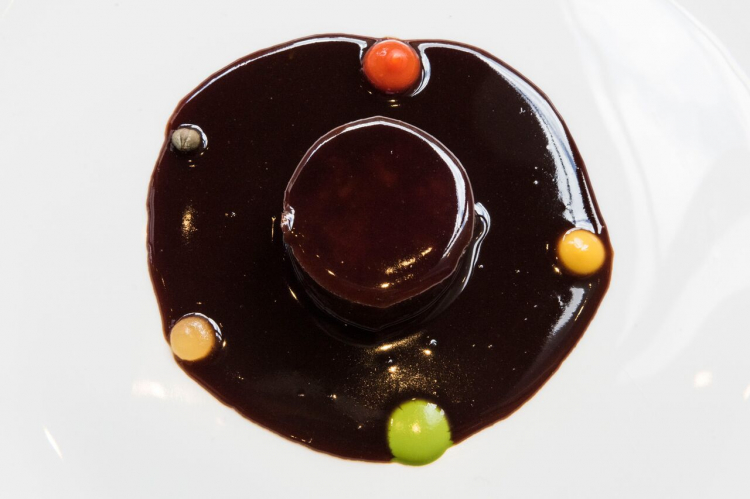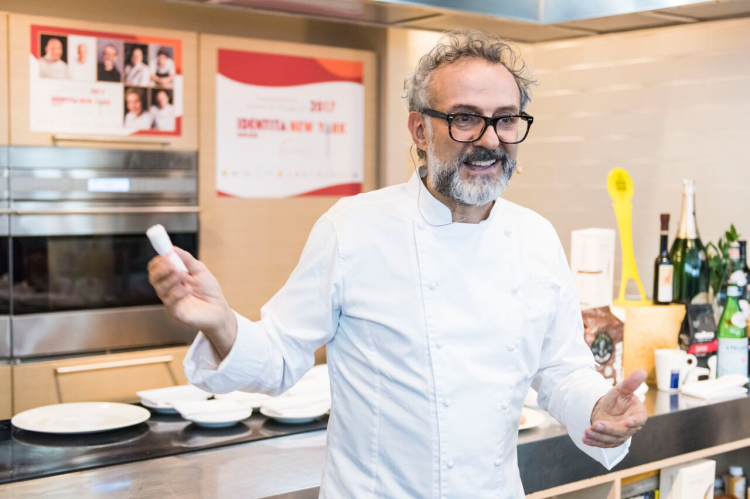Eight editions out of eight. Last night Massimo Bottura completed the set of lessons at Identità New York. There couldn’t have been a better finale for the 8th edition. And even though we knew the repertoire of the chef from Modena by heart («We need to analyse the past with criticism, not nostalgia», «Know everything and later forget everything», «Compress ideas into edible morsels»), it’s hard to be a cold reporter in front of such passionate speeches.
Yesterday Bottura not only summed up an idea in a dish, but the synthesis of an oeuvre based on thousands of gestures born from intuitions. A universal collection that was already clear from the name of the dish itself: “Sometimes partridge, sometimes mallard filled with bollito misto not boiled, in a civet cooked as a mole, with a chawanmushi of everything”.
«We start with ‘sometimes’», his journey across time begins, «because with game the unexpected is always round the corner: you ask for mallard and get partridge; ask for partridge and get mallard. The contemporary chef must always be alert». The breast of the mallard is filled with bollito non bollito, an iconic recipe in Via Stella which Bottura explains to the American audience in these words: «It’s a Christmas classic in northern Italy, but most of all it was a turning point in my journey. It was born as the answer to a question I asked myself when looking at the folds of a piece of meat raised in Piedmont by heroic artisans, in 2005. Why should I boil it in water? Nobody wondered this, for thousands of years. What if, by boiling it, you loose vitamins, proteins and all the most important nutrients? Vacuum cooking is so much better». This is the heuristic born from small questions, «from the impulse of conveying the best of the past into the future. From new urges».

Sometimes partridge, sometimes mallard, filled with bollito non bollito in a civet that becomes a mole
So the veal tongue is vacuum cooked for 30 hours (a little less for belly and tail). «But what should we do with the gelatinous and super-tasty scraps in the middle of the meat? We add foie gras so as to give the idea of a royale. With head, belly and foie gras we make a filling for the mallard. We put it in the pan, then in the steam oven and voilà».
Voilà so to speak, because we’re not even halfway down the road. «We still need the sauce, the most important element. We make a classic civet, in the fashion of Paul Bocuse. In this case too, we go beyond the original recipe. Let’s ask ourselves if it can be improved, if it’s up to date. In order to lose its frequent unbalance and its excessive flavours, I realised I had to draw from Mexican
mole. I infused the sauce in coffee grains, which enhance its bitter and toasted aromas, and added neat and intense Creole chocolate». So the civet becomes a mole, following the metamorphosis typical of his dishes. Another recipe that wins it all in Modena. «At
Francescana I serve it before the dessert: it’s the perfect bridge between sweet and savoury. A wise contamination that arises from travelling, the only possible dimension for us to become better people».

Bottura also presented his latest editorial work, "Bread is Gold", published by Phaidon, out in November. The book includes 65 recipes with left over ingredients, signed by the great chefs who cooked at Refettorio in Milan
But there’s more. «How about the bones? We can’t throw them away. Let’s make a very intense broth-custard, to be served on the side. A
chawanmushi with everything, with round pickles made from vegetables scraps: they give a little stimuli to the palate and add the acidity that erases the fattiness of the mole and the boiled meat». We’re almost done: «My mother always commanded: eat up or you can’t leave the table». The last 100 metres at the end of the run: «Some bread for dipping, with left over butter and a little truffle. It’s the best part of the dish»
So here we have all the pieces in Bottura’s philosophy: the unexpected (the game), tradition (bollito), evolution (non bollito), a classic (civet), the contamination (mole),
food waste (chawanmushi). We’ll add the effectiveness and the multi-faceted deliciousness of the dish. Sour, sweet, creamy, soft, crunchy, liquid, thick, pungent counterpoints. Even those who never had the luck to listen to these words would be filled with enthusiasm.
Translated into English by Slawka G. Scarso